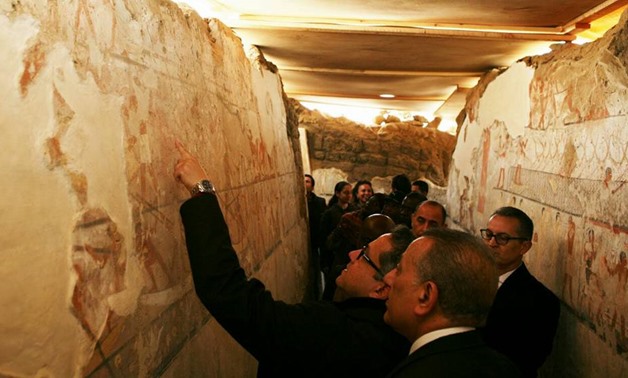
CAIRO – 4 February 2018: An Old Kingdom tomb was discovered in the Western Cemetery located in the Pyramids area in Giza to an ancient Egyptian woman named Hetpet, as announced on Saturday by the Egyptian Minister of Antiquities Khaled Anany.
CAIRO – 4 February 2018: An Old Kingdom tomb was discovered in the Western Cemetery located in the Pyramids area in Giza belonging to an ancient Egyptian woman named Hetpet, as announced on Saturday by the Egyptian Minister of Antiquities Khaled Anany.
Anany explained that the tomb dates back to the Fifth Dynasty, about 4,400 years ago. “This is the first archaeological discovery in 2018 but it will not be the last, it is expected that we will announce a new archaeological discovery in the upcoming few weeks,” recounted Anany.

An Egyptian archaeological mission led by Dr. Mostafa Waziry, secretary general of the Supreme Council of Antiquities, has discovered the tomb during excavation works carried out in the Giza western cemetery, which houses tombs of the Old Kingdom’s top officials discovered by previous archaeological missions since 1842.
 Who is Hetpet?
Who is Hetpet?
Hetpet was a woman with a high social position in ancient times; a top official in the royal palace during the end of the Fifth Dynasty. Hetpet has a number of cognomens among which is the priest of the goddess Hathour.
Hathour is a pharaonic goddess who symbolizes the principles of joy, feminine love, and motherhood. El Waziry announced that Hetpet played important roles at that time especially in the agricultural field.
 The architectural shape of Hetpet’s tomb
The architectural shape of Hetpet’s tomb
The newly discovered tomb of Hetpet has the architectural style and the decorative elements of the Fifth Dynasty with an entrance leading to an L-shaped shrine with a purification basin.
On its western rear end there is a rectangular arcade lined with incense and offering holders. There is also a naos with a yet missing statue of the tomb’s owner.
The tomb has very distinguished wall paintings in a well-conserved condition depicting Hetpet standing in different hunting and fishing scenes or sitting before a large offering table receiving offerings from her children.
“The tomb contains a group of dazzling inscriptions portraying rare amazing scenes like a monkey dancing in front of a complete musical troupe, a sailors’ fight, hunting birds, and fishing among others. All the inscriptions’ colors are very clear and bright,” El Waziry announced on Saturday.
Scenes of reaping fruits, melting metals and the fabrication of leather and papyri boats as well as musical and dancing performances are also shown on walls.
Among the most distinguished paintings in the tomb are those depicting two monkeys in two different positions.
Monkeys were domestic animals at the time. The first scene shows a monkey reaping fruits. Similar scenes are found in other tombs. The first one is painted on the wall of a 12th Dynasty tomb of Khnoum Hetep II in Beni Hassan in Minya Governorate and the second is found in an Old Kingdom tomb of Ka-Iber in Saqqara but it displays a dancing monkey in front of an instrumentalist not an orchestra.

Anany elaborated on Saturday that the excavation work in this area started in October 2017 and will continue in 2018 under the supervision of Mostafa El Waziry, the secretary-general of the Supreme Council of Antiquities.
Anany explained that the Western cemetery area was reserved for senior officials in the Pharaonic area. The famous Egyptian archeologist Zahi Hawass has previously discovered a group of ancient Egyptian tombs in this area.





Comments
Leave a Comment